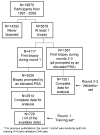A four-kallikrein panel predicts prostate cancer in men with recent screening: data from the European Randomized Study of Screening for Prostate Cancer, Rotterdam
- PMID: 20400522
- PMCID: PMC2891337
- DOI: 10.1158/1078-0432.CCR-10-0122
A four-kallikrein panel predicts prostate cancer in men with recent screening: data from the European Randomized Study of Screening for Prostate Cancer, Rotterdam
Abstract
Purpose: We have developed a statistical prediction model for prostate cancer based on four kallikrein markers in blood: total, free, and intact prostate-specific antigen (PSA), and kallikrein-related peptidase 2 (hK2). Although this model accurately predicts the result of biopsy in unscreened men, its properties for men with a history of PSA screening have not been fully characterized.
Experimental design: A total of 1,501 previously screened men with elevated PSA underwent initial biopsy during rounds 2 and 3 of the European Randomized Study of Screening for Prostate Cancer, Rotterdam, with 388 cancers diagnosed. Biomarker levels were measured in serum samples taken before biopsy. The prediction model developed on the unscreened cohort was then applied and predictions compared with biopsy outcome.
Results: The previously developed four-kallikrein prediction model had much higher predictive accuracy than PSA and age alone (area under the curve of 0.711 versus 0.585, and 0.713 versus 0.557 with and without digital rectal exam, respectively; both P < 0.001). Similar statistically significant enhancements were seen for high-grade cancer. Applying the model with a cutoff of 20% cancer risk as the criterion for biopsy would reduce the biopsy rate by 362 for every 1,000 men with elevated PSA. Although diagnosis would be delayed for 47 cancers, these would be predominately low-stage and low-grade (83% Gleason 6 T(1c)).
Conclusions: A panel of four kallikreins can help predict the result of initial biopsy in previously screened men with elevated PSA. Use of a statistical model based on the panel would substantially decrease rates of unnecessary biopsy.
(c) 2010 AACR.
Figures


Similar articles
-
Predictive value of four kallikrein markers for pathologically insignificant compared with aggressive prostate cancer in radical prostatectomy specimens: results from the European Randomized Study of Screening for Prostate Cancer section Rotterdam.Eur Urol. 2013 Nov;64(5):693-9. doi: 10.1016/j.eururo.2013.04.040. Epub 2013 May 2. Eur Urol. 2013. PMID: 23683475 Free PMC article. Clinical Trial.
-
Impact of recent screening on predicting the outcome of prostate cancer biopsy in men with elevated prostate-specific antigen: data from the European Randomized Study of Prostate Cancer Screening in Gothenburg, Sweden.Cancer. 2010 Jun 1;116(11):2612-20. doi: 10.1002/cncr.25010. Cancer. 2010. PMID: 20336781 Free PMC article.
-
Reducing unnecessary biopsy during prostate cancer screening using a four-kallikrein panel: an independent replication.J Clin Oncol. 2010 May 20;28(15):2493-8. doi: 10.1200/JCO.2009.24.1968. Epub 2010 Apr 26. J Clin Oncol. 2010. PMID: 20421547 Free PMC article. Clinical Trial.
-
4-Kallikrein Test and Kallikrein Markers in Prostate Cancer Screening.Urol Clin North Am. 2016 Feb;43(1):39-46. doi: 10.1016/j.ucl.2015.08.004. Urol Clin North Am. 2016. PMID: 26614027 Review.
-
[PSA and hK2 in the diagnosis of prostate cancer].Actas Urol Esp. 2008 Jun;32(6):575-88. doi: 10.1016/s0210-4806(08)73891-9. Actas Urol Esp. 2008. PMID: 18655340 Review. Spanish.
Cited by
-
Predicting high-grade cancer at ten-core prostate biopsy using four kallikrein markers measured in blood in the ProtecT study.J Natl Cancer Inst. 2015 Apr 11;107(7):djv095. doi: 10.1093/jnci/djv095. Print 2015 Jul. J Natl Cancer Inst. 2015. PMID: 25863334 Free PMC article.
-
A Four-kallikrein Panel Predicts High-grade Cancer on Biopsy: Independent Validation in a Community Cohort.Eur Urol. 2016 Mar;69(3):505-11. doi: 10.1016/j.eururo.2015.04.028. Epub 2015 May 13. Eur Urol. 2016. PMID: 25979570 Free PMC article.
-
Kallikreins as biomarkers for prostate cancer.Biomed Res Int. 2014;2014:526341. doi: 10.1155/2014/526341. Epub 2014 Apr 7. Biomed Res Int. 2014. PMID: 24809052 Free PMC article. Review.
-
Molecular Biomarkers in the Clinical Management of Prostate Cancer.Cold Spring Harb Perspect Med. 2018 Nov 1;8(11):a030601. doi: 10.1101/cshperspect.a030601. Cold Spring Harb Perspect Med. 2018. PMID: 29311125 Free PMC article. Review.
-
Tumor markers in prostate cancer I: blood-based markers.Acta Oncol. 2011 Jun;50 Suppl 1(Suppl 1):61-75. doi: 10.3109/0284186X.2010.542174. Acta Oncol. 2011. PMID: 21604943 Free PMC article. Review.
References
-
- Schroder FH, Hugosson J, Roobol MJ, et al. Screening and prostate-cancer mortality in a randomized European study. N Engl J Med. 2009;360:1320–8. - PubMed
-
- Ulmert D, Serio AM, O'Brien MF, et al. Long-term prediction of prostate cancer: prostate-specific antigen (PSA) velocity is predictive but does not improve the predictive accuracy of a single PSA measurement 15 years or more before cancer diagnosis in a large, representative, unscreened population. J Clin Oncol. 2008;26:835–41. - PubMed
Publication types
MeSH terms
Substances
Grants and funding
LinkOut - more resources
Full Text Sources
Other Literature Sources
Medical
Research Materials
Miscellaneous

